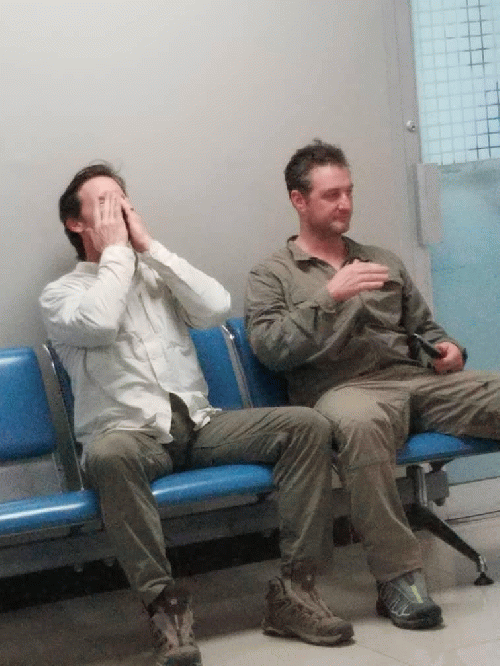There are things we know about the mercenaries, things we do not know, and motives we can only guess at.
In fact, before the news of the arrest of the mercenaries by the Haitian National Police was revealed on CNN, the story was flooding Twitter, Instagram and Facebook accounts. Photos of the men, their passports, the weapons cache and their names were easily available, as well as videos of their detention. Other photos showed the group cooling their heels in the VIP lounge at Toussaint Louverture Airport while awaiting a flight out of Haiti on a regularly scheduled American Airlines flight. So how and why did CNN get the numbers and the names wrong? You would assume they monitor social media.
In 1980, the magazine Tricontinental, published by the "Organization of Solidarity with the People of Asia, Africa and Latin America (OSPAAAL)," dedicated its issue no. 119 to Haiti. The editors wrote, "Very little is known about the Haitian people's struggle, as the imperialists have erected a wall of silence around Haiti."
To be completely fair, an understanding of Haitian history and 250 years of domination by the world's superpowers cannot be explained in a two minute report on the evening news or five inches or less of print copy. A savant's knowledge of Haitian history is not required to understand that when the CORE group of Nations (composed of the Special Representative of the United Nations Secretary-General, the Ambassadors of Brazil, Canada, France, Germany, Spain, the European Union, the United States of America, and the Special Representative of the Organization of American States) cannot control the Haitian populace, the group sends in the U.N. or mercenaries to do the job.
In 1915 Woodrow Wilson sent in the marines to massacre the participants in a rebellion. Twenty years later Secretary of State James Blaine unsuccessfully tried to obtain MÃ �le-Saint-Nicolas, a northern Haitian settlement, for a naval base. MÃ �le-Saint-Nicolas figures heavily today in the saga of Haitian Joseph Baptiste, a former member of the U.S. military, who was caught by the FBI in a pay-to-play scheme for port access. The federal case is ongoing. After nineteen years of the U.S. occupation, more than fifteen thousand Haitians (a conservative count) were killed. In 2004 President Aristide was ousted, and in the immediate aftermath of the 2010 earthquake, the CORE group discussed a possible coup against President Rene Preval. The U.S. State Department manipulated the 2010 election results, and only 19-21percent (generous estimate) of the electorate voted in 2016.
THE TIMELINE
A timeline of the arrival and departure of the American mercenaries is the framework for what we know, and a good example of how things have not changed.
Sometime in the night of February 15 or early February 16, seven heavily armed men arrived in Haiti and met their Haitian driver. How they got into the country remains a mystery, since their passports were not stamped. They were met by President Jovenel Moise's senior advisor, Jean Fritz Jean Louis, and brought to their hotel. Internet chatter noticed the arrival of what people assumed were "journalists."
On February 14 the U.S. State Department issued another Level-4 "do not travel" to Haiti red advisory, due to continuing massive protests advocating the removal of President Moise on corruption charges.
"There are currently widespread, violent, and unpredictable demonstrations in Port-au-Prince and elsewhere in Haiti. Due to these demonstrations, on February 14, 2019, the Department of State ordered the departure of all non-emergency U.S. personnel and their family members. The U.S. government has limited ability to provide emergency services to U.S. citizens in Haiti."
On Sunday afternoon the men were stopped and arrested at a routine roadblock by the Haitian National Police. There were no license plates on the Toyota Prado and Ford pickup that have since been connected to individuals close to Moise. The Police found five different license plates in the car, along with the trove of assault weaponry.
The Miami Herald reported from Port au Prince that after facing charges of criminal conspiracy, "They (the seven men) said that they were here (in Haiti) on a 'government mission. They did not specify which government, but told the police that.-- their boss was going to call their boss."
Who were the bosses? We still do not know, but there are hints to follow.
How did they obtain a vehicle?
Prime Minister Jean-Henry Ce'ant, whose secretary has an office directly opposite the bank, claims to be in possession of a letter (we have the letter) from Behrmann Motors documenting that one of the vehiclesa Ford Ranger with serial number SA2LPJJ77628is registered in the name of Jean Fritz Jean Louis. Magalia Habitant, who at the time was Director of the Metropolitan Waste Collection Service, purchased the Ford Ranger last August.
(Note: You can view every article as one long page if you sign up as an Advocate Member, or higher).






